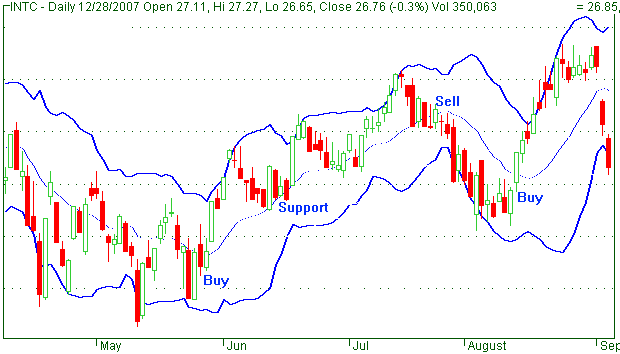|
New Page 2
Bollinger Bands
Bollinger Bands are a technical analysis tool invented by John Bollinger
in the 1980s. Having evolved from the concept of trading bands, Bollinger
Bands can be used to measure the highness or lowness of the price relative
to previous trades.
Bollinger Bands consist of:
-
a
middle band being a N-period simple moving average
-
an
upper band at K times a N-period standard deviation above the middle band
-
a lower
band at K times a N-period standard deviation below the middle band
Typical
values for N and K are 20 and 2, respectively.

Predictive value
The bands cannot, as some have supposed, be used to make reliable
statements regarding what fraction of an equity's prices will lie within a
certain distance of the mean value. This is because an individual equity's
price does not obey known distribution functions. For example, if the
bands for plus or minus two standard deviations (2SD) are computed, it is
wrong to suppose that ~95% of an equity's closing prices will, on average,
lie within the Bollinger bands. That would require, among other things,
that the prices be normally distributed, which they are generally not. It
would further require that the true standard deviation be known. The
standard deviation calculated as above, however, is only an uncertain
estimate of the true standard deviation. Furthermore, it should be
realized that the "standard deviations" of stock prices for finite time
periods are not fixed parameters as required to apply classical
statistical theory, but instead are variables in constant flux depending
on price volatility. The bands give a visual picture of a stock's price
volatility. Nevertheless, the bands can be useful in the technical
analysis of prices or returns and by Chebyshev's inequality must contain
at least 75% of prices. These occurrences should be considered in relation
to other factors before making investment decisions.
It is of interest to note that faulty interpretation of a price touching
or breaching a band based on incorrect statistical assumptions has become
so widespread that some traders now use these events alone as trading
signals and by so doing may have unwittingly injected significance into
these band-touching events that should otherwise be absent. Nevertheless,
anyone can observe over time, that for a diversified group of mutual
funds, say, the proportion of daily adjusted close prices that breach
their 1-month 2SD Bollinger bands varies between 5% and 15% of days, with
each fund having a fairly constant, characteristic long-term breach
probability descriptive of its long-term, relative volatility.
When the bands lie close together a period of low volatility in stock
price is indicated. When they are far apart a period of high volatility in
price is indicated. When the bands have only a slight slope and lie
approximately parallel for an extended time the price of a stock will be
found to oscillate up and down between the bands as though in a channel.
Interpretation
The use of Bollinger Bands varies wildly among traders. Some traders buy
when price touches the lower Bollinger Band and exit when price touches
the moving average in the center of the bands. Other traders buy when
price breaks above the upper Bollinger Band or sell when price falls below
the lower Bollinger Band. Moreover, the use of Bollinger Bands is not
confined to stock traders; options traders, most notably implied
volatility traders, often sell options when Bollinger Bands are
historically far apart or buy options when the Bollinger Bands are
historically close together, in both instances, expecting volatility to
revert back towards the average historical volatility level for the stock.
|
